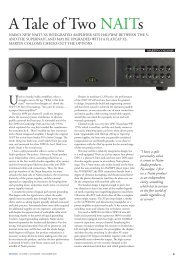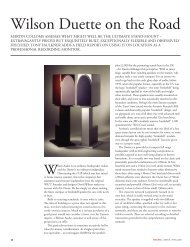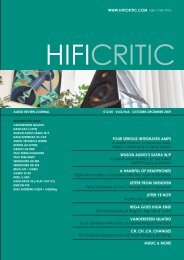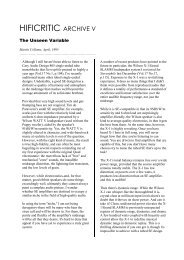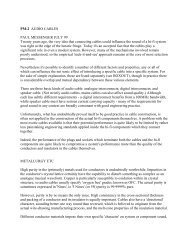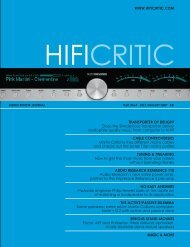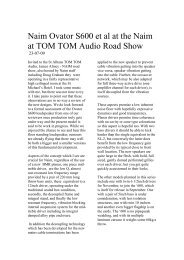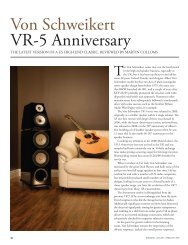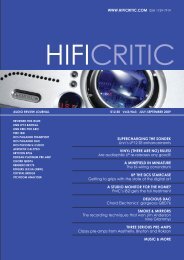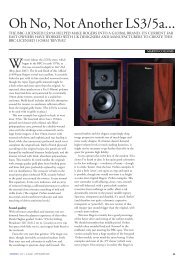Download - Hificritic.com
Download - Hificritic.com
Download - Hificritic.com
You also want an ePaper? Increase the reach of your titles
YUMPU automatically turns print PDFs into web optimized ePapers that Google loves.
BridgeCo Networked Audio Adapter<br />
……………………………..<br />
Mike Smyth, pronounced ‘Smith’, of Smyth Research, gave a talk on a virtualisation<br />
algorithm dubbed SVS, which looked intriguing, and unquestionably had a stunning<br />
auditory impact when auditioned. I think that it has relevance to home stereo and I will<br />
try to briefly explain what it is and what it is for. Initially the algorithm forms the heart<br />
of a portable studio monitoring system including for multiple channel surround sound.<br />
The ‘monitoring system’ may nevertheless be packed in a bag or two, and <strong>com</strong>prises a<br />
clever box incorporating the vital algorithm and a pair of top quality, open backed Stax<br />
electrostatic headphones.<br />
We have all played with binaural for years and then the industry has gone farther with<br />
more sophisticated HRTF syntheses, leading to higher performance spatialisers both for<br />
loudspeaker stereo and for headphone reproduction. For Smyth, the objective is not<br />
simply clever tricks, but to try to replicate the ‘sound’ of a full free space loudspeaker<br />
monitoring system in its natural studio environment yet reproduced on portable<br />
headphones. It is done by placing the engineer in the chosen environment and permitting<br />
ten or so minutes of precision HRTF measurement including the use of point<br />
microphones placed at the subject’s ear canal entrance. The SVS algorithm is created<br />
from the acoustic measurements.<br />
In operation in<strong>com</strong>ing stereo and multi channel audio signal is <strong>com</strong>puted, convolved<br />
with the SVS algorithm to create a two channel signal to the headphones, this the<br />
<strong>com</strong>plex sound pressure field which would have arriving at the listeners’ ears if he or<br />
she were present in the original sound field. In theory the listener then hears the raw<br />
music tracks, via the mix down process for which there is also a local mixer, e.g. Sonic<br />
Solutions or whatever, and the sound of the aimed for mix down in a real studio is<br />
virtualised, recreated for the user. One of the primary features considered important for<br />
maintaining a sense of reality is to somehow master the movement of the sound field<br />
such that when the monitoring engineer moves his head the orchestra does not follow<br />
round unnaturally like a dizzy carousel, as it usually does. Thus a head movement tracker<br />
is included and as you move your head to face a virtual source that source remains<br />
naturally fixed in position, and moreover the sound character of the virtual source is




